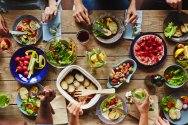Background
Six dilemmas – part 1: how will the Netherlands contribute to the global food supply?
The world population is expected to increase to some 9.7 billion people by 2050, while well over two billion people currently lack food security. How can we sustainably feed the growing population, and what role can the Netherlands play in this effort?
As a result of its favourable natural conditions, innovation and export, the Netherlands plays a key role in the global food supply. However, intensive agriculture has reached its limits. That begs the question: on what scale does the Netherlands wish to contribute? Will we focus on the Dutch market (self-supporting), the Northern European market (currently our largest sales market) or the global market? And what products will we export? Will we continue to export primary products such as meat and vegetables and continue as a transit port for products, or will we export mainly raw materials, technology and expertise?
The current situation is one where the Netherlands has insufficient farmlands to feed its population and must, therefore, import products such as grain and palm oil. Most of the export is destined for the Berlin-Paris-London triangle. One-third of the export consists of imported products shipped through the Netherlands. Land in the Netherlands is scarce and thus expensive, which is why the Netherlands produces and exports mainly high-value agricultural products and technology.
The Netherlands must consider its trade position in light of climate change, the nitrogen crisis, recovering biodiversity and the energy transition. These sustainability targets restrict crop farming and livestock farming, while the biobased economy results in new claims on plant-based materials and land.
What options are there?
- The Netherlands can choose to focus entirely on contributing to the global food supply. That means that the Netherlands must develop raw materials and innovative technology to develop sustainable food systems here and elsewhere. This strategy requires less land in the Netherlands but does need sizeable intensive production systems, enabling the plant breeding and livestock systems sectors to stay ahead.
- By contrast, a completely different option would be for the Netherlands to recuse itself from the global food supply and opt for an extensive agricultural model with a different earning model, shorter chains and local markets where farmers are paid to produce less food and deliver more ecosystem services. In this scenario, the Netherlands remains dependent on food imports, and the agro-food sector no longer contributes to the Dutch economy.
- A third possibility is based on a European food strategy. In this scenario, Europe aims to become self-reliant in view of the global geopolitical instability. This perspective underscores the fact that climate change, urbanisation and natural development cause the amount of farmland in Europe to decline. At the same time, agriculture is (too) dependent on fossil energy, phosphate and potash, labour and water. How can Europe produce sufficient food under these circumstances? And how will the Netherlands contribute to this European food agenda? In this scenario. The Netherlands will continue to export food such as potatoes, meat, vegetables and fruit, as well as raw materials, intensively and sustainably. But it will cease to invest in horticulture and biobased crops that are not residual streams.
WUR is in favour of discussing these issues at the level of (North-Western) Europe since the Netherlands is part of the European market and trades primarily with neighbouring countries. Moreover, many parties within the chain are active at a European level, and legislation for food is largely identical throughout Europe. Regarding the global food supply, there is the question of whether the Dutch agro-food sector still plays an exemplary role in the world, with its focus on agricultural and technological innovations, productivity and efficiency.
6 dilemmas
The societal debate on agriculture and nature frequently focuses on slashing the livestock population in half and whether we should aim to achieve the nitrogen targets in 2030 or in 2035. But are there the right questions? A group of Wageningen researchers identified six dilemmas contributing to the Netherlands’ future course of agriculture and nature.
In the series “6 Dilemmas”, each of the dilemmas is discussed in more detail.


